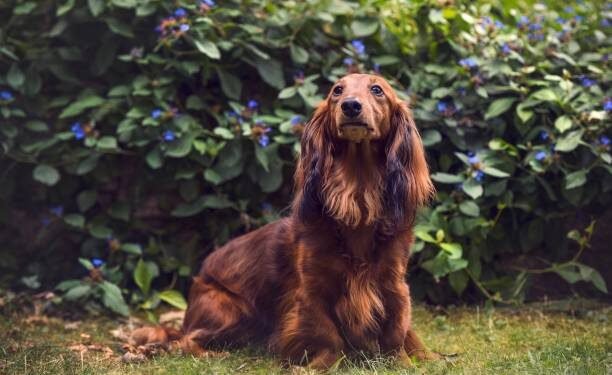Introduction
Are you intrigued by the charming and distinctive long haired Dachshund? These small dogs are not just known for their unique appearance but also their delightful personalities. In this comprehensive guide, we’ll delve into every aspect of the long haired Dachshund breed, from their physical characteristics to their care requirements. But before we dive into the details, let’s start with an interesting fact about these lovable dogs.
Did you know that the long haired Dachshund is not just a breed of dog but also a piece of living art with their flowing and silky coats? Their appearance has captured the hearts of many dog enthusiasts, making them a sought-after breed in the world of canine companions.
The purpose of this guide is to serve as a go-to resource for all things related to long haired Dachshunds. Whether you’re considering bringing one into your home or simply want to learn more about this captivating breed, you’ll find everything you need right here.
While information about Dachshunds, in general, is readily available, the long haired variety possesses unique characteristics and care requirements that deserve special attention. This guide aims to bridge the gap by providing up-to-date and comprehensive insights into the world of long haired Dachshunds.

Long Haired Dachshund at a Glance
Before we dive deeper into the specifics, let’s start by getting a quick overview of the long haired Dachshund breed. The table below summarizes key characteristics of these charming dogs.
| Field | Information |
|---|---|
| Height | Varies, typically 8 to 9 inches (20 to 23 cm) |
| Weight | Typically 11 to 32 pounds (5 to 15 kg) |
| Life Span | 12 to 16 years (varies with care) |
| Good with | Children, families, singles |
| Temperament | Playful, curious, loyal, sometimes stubborn |
| Intelligence | Highly intelligent, but can be independent |
| Shedding Amount | Moderate |
| Grooming | Regular brushing required |
| Exercise Needs | Moderate, daily walks and playtime |
| Energy Level | Moderate |
| Barking Level | Moderate |
| Drool Amount | Minimal |
| Coat Length/Texture | Long and silky |
| Colors | Various, including red, black, cream, and more |
| Patterns | Solid, dapple, piebald, and more |
Please note that the exact characteristics may vary from one long haired Dachshund to another, but this table provides a general overview of what you can expect from this charming breed. In the following sections, we will explore each of these aspects in detail to help you better understand and care for your long haired Dachshund companion.
Table of Contents
Breed History and Origin of the Long Haired Dachshund
The long haired Dachshund, with its enchanting appearance and captivating personality, has a rich history that dates back centuries. In this section, we will journey through time to explore the origins of this remarkable breed, uncovering the key events and breeds that have shaped the long haired Dachshund into the beloved companion we know today.
Exploring Their Roots
The long haired Dachshund’s ancestry can be traced to Germany, where it was initially bred for a very specific purpose: hunting. These pint-sized hounds were developed to track and flush out burrow-dwelling animals like badgers, rabbits, and foxes from their underground lairs. To excel in this role, several breeds were carefully crossed, contributing their unique qualities to the Dachshund gene pool. Notable breeds that played a part in the formation of the Dachshund include:
1. Dachs – The name “Dachshund” itself gives a clue to its purpose. “Dachs” in German translates to “badger,” and these dogs were bred to be “badger hounds.”
2. Hound Breeds – The Dachshund’s excellent sense of smell and hunting skills were enhanced by breeding with various hound breeds, such as the Bavarian Hound and the Bracken. This infusion of hound blood contributed to their keen tracking abilities.
3. Terriers – To handle the challenge of subterranean hunting, terrier breeds like the Dandie Dinmont Terrier were introduced into the Dachshund’s lineage. Terriers brought the tenacity needed for going underground to confront game.
The careful selection of these breeds resulted in a unique combination of traits ideally suited for the demanding task of hunting in challenging terrains. As a result, the Dachshund became renowned for its ability to track, dig, and face off against much larger opponents when necessary.
Notable Traits
Distinctive Body Shape: One of the most distinguishing features of the Dachshund is its elongated body and short legs, which allowed it to burrow into tight spaces and navigate underground tunnels with ease.
Versatile Coat Variations: While we are focusing on the long haired Dachshund in this guide, it’s important to note that Dachshunds come in three coat types: smooth, long-haired, and wire-haired. The long haired variety stands out with its luxurious, silky coat that requires special grooming attention.
Loyal and Curious Nature: Beyond their physical traits, Dachshunds are known for their unwavering loyalty to their owners and a curious, sometimes stubborn, personality that can charm even the most skeptical of hearts.
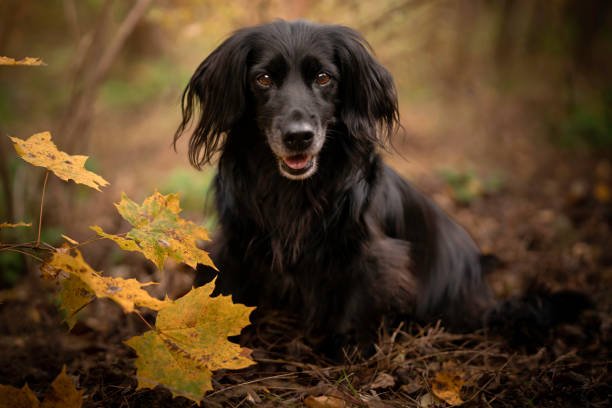
Relevance of Origin
Understanding the historical purpose of the long haired Dachshund is key to comprehending their characteristics and behaviors today. These dogs were bred to be tenacious hunters, and that determination is still very much a part of their DNA. Here’s how their origin influences their present-day traits:
Fearless Hunters: The long haired Dachshund’s ancestors had to confront formidable opponents like badgers underground. This history has bred courage and determination into the breed, making them surprisingly fearless despite their small size.
Independent Thinkers: Dachshunds are known for their independent nature. This trait likely developed as a survival mechanism, as they needed to make quick decisions while hunting in challenging conditions.
Loyal Companions: Despite their hunting prowess, Dachshunds have always been cherished as loyal companions. Their loyalty and affection for their owners are deeply ingrained and have not wavered over the centuries.
In conclusion, the long haired Dachshund’s history is a fascinating tapestry woven with threads of courage, determination, and loyalty. These qualities, instilled through generations of selective breeding, continue to make the long haired Dachshund a beloved breed today. In the following sections, we will explore the unique characteristics, care requirements, and tips for welcoming one of these delightful dogs into your home.
Understanding the Long Haired Dachshund Breed’s Traits
In this section, we will delve deeper into the unique traits that define the long haired Dachshund breed. From their physical characteristics to their temperament, and even their environmental needs, we’ll provide you with a comprehensive understanding of what to expect when considering this breed as a family pet.
Physical Characteristics
The long haired Dachshund is renowned for its distinctive appearance, combining elegance and charm in a compact package.
Size and Proportions
- Height: Long haired Dachshunds typically stand at a height of 8 to 9 inches (20 to 23 cm) at the shoulder.
- Weight: They usually weigh between 11 to 32 pounds (5 to 15 kg), with variations among individuals.
Coat Type and Colors
The long haired Dachshund’s crowning glory is its beautiful, silky coat, which sets it apart from its short-haired and wire-haired counterparts. The coat is long, flowing, and requires regular grooming to maintain its pristine condition.
Colors: Long haired Dachshunds come in a variety of colors, including:
- Red: A rich and deep shade of red.
- Black and Tan: Black with tan markings on the eyebrows, muzzle, chest, and paws.
- Chocolate and Tan: Chocolate brown with tan markings.
- Cream: A light, creamy color.
- Dapple: A mottled or spotted pattern over a base color.
- Piebald: A white coat with patches of any of the above colors.
Distinguishing Features
Beyond their flowing coats, long haired Dachshunds exhibit some other notable features:
- Elongated Body: Their elongated, low-slung body is well-suited for burrowing into tunnels and tight spaces.
- Expressive Eyes: They have dark, expressive eyes that convey their inquisitive nature.
- Floppy Ears: Dachshunds have floppy ears that frame their faces and add to their adorable appearance.
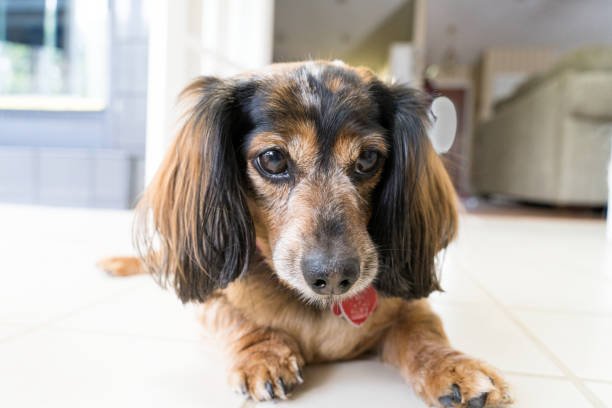
Temperament Overview
Understanding the temperament of the long haired Dachshund is crucial for potential owners. These dogs are known for their distinctive personality traits.
Suitability as Family Pets
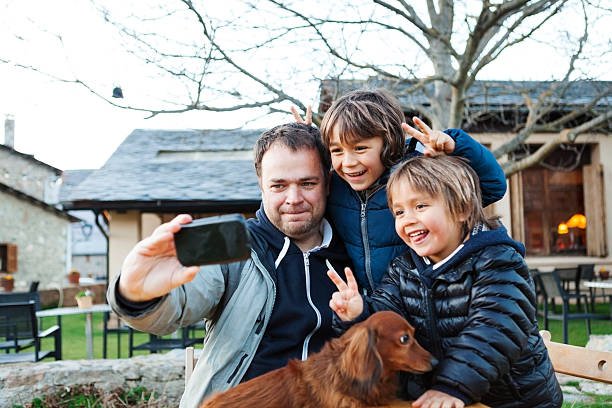
Long haired Dachshunds can make wonderful family pets, but it’s essential to consider their temperament when bringing them into a household.
- Loyal and Affectionate: They form strong bonds with their owners and are often loyal to a fault.
- Playful and Curious: Dachshunds are known for their playful nature and curiosity about their surroundings.
- Stubbornness: While they are intelligent, they can also be a bit stubborn, which can make training challenging at times.
Safe with Children
Dachshunds, including the long haired variety, are generally good with children, especially when raised together. However, their small size means that they should be handled gently to prevent accidental injury. Supervision is essential when Dachshunds are around young children to ensure that both the dog and child interact safely.
Compatibility with Other Pets
With proper socialization, long haired Dachshunds can get along well with other dogs and pets in the household. Early exposure to different animals and experiences is crucial in ensuring harmonious relationships.
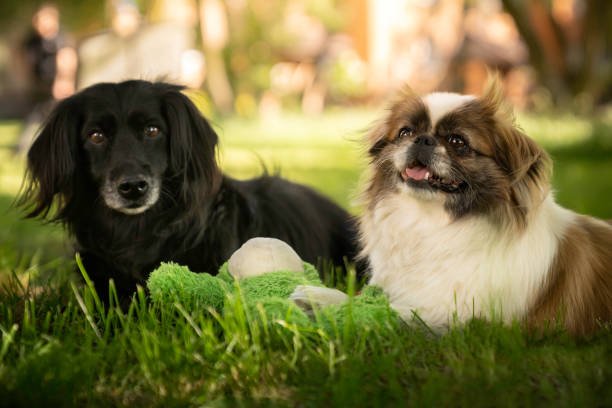
Environmental Needs
Understanding the environmental needs of the long haired Dachshund is vital to providing them with a comfortable and happy life.
Space Requirements
Long haired Dachshunds are adaptable to various living situations. They can thrive in apartments or houses with small yards. However, they do enjoy outdoor activities, so regular walks and playtime are essential to keep them mentally and physically stimulated.
Temperature Sensitivity
Dachshunds are sensitive to extreme temperatures, both hot and cold, due to their low-slung bodies. During hot weather, it’s crucial to prevent overheating, and in cold weather, provide them with adequate warmth through coats or indoor heating.
Training and Socialization
Proper training and socialization are keys to ensuring that your long haired Dachshund grows into a well-behaved and balanced companion.
Trainability
Dachshunds are intelligent but can have an independent streak, making training a mix of challenge and reward. Consistency, positive reinforcement, and patience are essential when training a long haired Dachshund. Early training is particularly crucial to establish good behaviors.
Socialization
Early socialization is equally vital. Expose your long haired Dachshund to various people, places, and situations to ensure they grow up to be confident and well-adjusted dogs. Socialization helps reduce any tendencies towards shyness or aggression.
In conclusion, the long haired Dachshund is a breed with a distinctive appearance and an equally unique personality. Understanding their physical traits, temperament, environmental needs, and the importance of training and socialization is essential when considering them as companions. In the next section, we will explore the specific care requirements for long haired Dachshunds, ensuring that they lead happy and healthy lives in your care.
Health Considerations and Care for Long Haired Dachshunds
Ensuring the health and well-being of your long haired Dachshund is paramount to providing them with a happy and fulfilling life. In this section, we will explore the common health issues that the breed may be prone to, tips for promoting a longer lifespan, dietary needs, exercise requirements, and grooming practices that will keep your long haired Dachshund looking and feeling their best.
Common Health Issues
While long haired Dachshunds are generally robust dogs, they can be prone to specific health issues. It’s crucial to be aware of these conditions and to schedule regular veterinary check-ups to catch and address any problems early.
Intervertebral Disc Disease (IVDD)
IVDD is a condition that commonly affects Dachshunds due to their elongated backs. It occurs when the discs between the vertebrae in the spine rupture or bulge, leading to pain, mobility issues, and, in severe cases, paralysis. Keeping your Dachshund at a healthy weight and avoiding activities that strain their back can help prevent this condition.
Obesity
Dachshunds are prone to obesity, which can exacerbate other health issues, including IVDD. Maintain a balanced diet and ensure they get regular exercise to keep them at a healthy weight.
Hip Dysplasia
Hip dysplasia is a genetic condition that affects the hip joints, leading to pain and reduced mobility. While not as common in Dachshunds as in some larger breeds, it can still occur. Responsible breeding practices can help reduce the risk.
Eye and Ear Issues
Dachshunds, including long haired ones, may be susceptible to eye conditions like cataracts and progressive retinal atrophy (PRA). Regular eye examinations by a veterinarian are essential. Ear infections can also be a concern, given their floppy ears, so regular cleaning and inspection are important.
Dental Problems
Dachshunds may develop dental issues, such as tartar buildup and gum disease. Regular dental care, including brushing their teeth and providing dental chews, can help maintain oral health.
Lifespan and Longevity
The average lifespan of a long haired Dachshund typically ranges from 12 to 16 years. However, with proper care, some individuals have been known to live even longer. Here are some tips to promote a longer and healthier life for your Dachshund:
Regular Veterinary Check-ups
Schedule routine check-ups with your veterinarian to catch and address any health concerns early. Vaccinations, preventive medications, and dental care should be part of the routine.
Healthy Diet and Portion Control
Feed your Dachshund a balanced diet tailored to their age, size, and activity level. Avoid overfeeding, as obesity can lead to various health problems. Consult your veterinarian for dietary recommendations.
Exercise and Mental Stimulation
Long haired Dachshunds are active and curious dogs. Provide daily exercise through walks, playtime, and interactive toys to keep them physically and mentally engaged. Mental stimulation can be as important as physical activity.
Diet and Nutrition
Proper nutrition is vital for the health and well-being of your long haired Dachshund. Here are some dietary considerations:
Quality Dog Food
Choose a high-quality dog food that meets the specific nutritional needs of your Dachshund. Look for options formulated for small breeds, as these often provide the right balance of nutrients.
Portion Control
Avoid overfeeding, as Dachshunds are prone to obesity. Follow the feeding guidelines on the dog food packaging and consult your veterinarian to determine the appropriate portion size for your individual dog.

Feeding Schedule
Establish a regular feeding schedule to help regulate your Dachshund’s metabolism and prevent overeating. Most adult Dachshunds do well with two meals a day.
Fresh Water
Always provide access to fresh, clean water. Proper hydration is essential for overall health.
Exercise and Activity
Long haired Dachshunds are active dogs that enjoy physical activity and mental stimulation. Here’s how to meet their exercise needs:
Daily Walks
Take your Dachshund for daily walks to provide both physical exercise and mental enrichment. Aim for at least 30 minutes of walking per day, but adjust based on your dog’s age and energy level.
Interactive Playtime
Engage in interactive play sessions with toys like puzzle feeders, balls, and squeaky toys. These activities challenge their minds and provide an outlet for their energy.
Socialization
Expose your Dachshund to different environments, people, and other dogs to promote socialization and prevent behavioral issues. Early socialization is crucial for their development.
Grooming and Maintenance
Maintaining your long haired Dachshund’s coat and overall hygiene is essential for their comfort and health.
Coat Care
Long haired Dachshunds require regular brushing to prevent matting and tangling of their silky fur. Aim to brush them at least a few times a week to keep their coat in top condition.
Ear and Eye Cleaning
Inspect and clean your Dachshund’s ears regularly to prevent infections. Use a damp cloth to clean the area around their eyes to prevent tear staining.
Dental Care
Brush your Dachshund’s teeth regularly to prevent dental issues. Dental chews and toys can also help maintain oral health.
Shedding*
While long haired Dachshunds do shed, it’s typically less than short-haired breeds. Regular brushing can help manage shedding and keep your home relatively fur-free.
In conclusion, taking care of a long haired Dachshund involves proactive health management, proper nutrition, regular exercise, and attentive grooming. By understanding and addressing their specific needs, you can ensure that your long haired Dachshund lives a happy, healthy, and fulfilling life as a cherished member of your family.
Choosing and Adopting a Long Haired Dachshund Dog Breed
Adopting a long haired Dachshund can be a rewarding experience, but it also comes with responsibilities and considerations. In this section, we will explore the reasons for adopting this breed, the research and preparation required, the adoption process, and ethical considerations related to breeding.
Reasons for Adoption
Adopting a long haired Dachshund offers a host of benefits, not only for potential owners but also for the dogs themselves.
Giving a Second Chance
One of the most significant reasons to adopt a long haired Dachshund is the opportunity to provide a loving home to a rescue dog. Many Dachshunds end up in shelters or rescue organizations due to various reasons, including changes in their owners’ circumstances. By adopting, you give a dog a second chance at a happy life.
Loyal Companionship
Long haired Dachshunds are known for their loyalty and affection. When you adopt one, you gain a steadfast companion who will be by your side through thick and thin.
Reducing Overpopulation
Choosing adoption over purchasing from a breeder or pet store helps reduce the problem of pet overpopulation. By giving a home to a rescue Dachshund, you indirectly contribute to the well-being of animals in need.
Supporting Rescue Organizations
When you adopt, you support the valuable work of rescue organizations. These groups work tirelessly to rescue, rehabilitate, and rehome dogs, and your adoption fee helps fund their efforts.
Research and Preparation
Before bringing a long haired Dachshund into your home, thorough research and preparation are essential to ensure a smooth transition for both you and your new furry friend.
Understanding Breed-Specific Needs
Long haired Dachshunds, like all breeds, have specific needs and characteristics. Research the breed thoroughly to understand their temperament, exercise requirements, grooming needs, and any potential health issues. This knowledge will help you provide the best care possible.
Financial Responsibilities
Owning a dog, whether through adoption or purchase, comes with financial responsibilities. Be prepared for expenses such as food, grooming, veterinary care, and unexpected medical bills. Ensure you have the financial means to provide for your Dachshund’s needs.
Creating a Safe Environment
Prepare your home for the arrival of your new Dachshund. Puppy-proof your living space by removing hazards and providing a safe, comfortable area for your dog to sleep and play. Ensure you have the necessary supplies, including food, bowls, a leash, collar, and identification tags.
Adoption Process
Adopting a long haired Dachshund involves several steps, typically facilitated by rescue organizations or breed-specific clubs. Here’s what you can expect during the adoption process:
Application
Start by filling out an adoption application provided by the rescue organization or breeder. This application helps them assess your suitability as a dog owner and match you with a Dachshund that fits your lifestyle.
Home Visit
Many rescue organizations conduct home visits as part of the adoption process. A representative will visit your home to ensure it’s a safe and suitable environment for the dog. This step is meant to ensure the well-being of the dog.
References
Be prepared to provide references as part of your application. These references may include your veterinarian and personal acquaintances who can vouch for your responsibility as a pet owner.
Adoption Fees
Most rescue organizations charge adoption fees to cover the costs of vaccinations, spaying or neutering, and other medical care. The adoption fee can vary but is generally a fraction of the expenses incurred by the organization in preparing the dog for adoption.
Waiting Period
After completing the application and home visit, there may be a waiting period as the organization processes your application and matches you with an appropriate Dachshund.
Finalization and Bringing Your Dachshund Home
Once your application is approved, the finalization process takes place. You will complete any remaining paperwork and pay the adoption fee. You’ll then bring your new long haired Dachshund home, where the real journey of companionship begins.
Breeding and Ethical Considerations
While adopting a long haired Dachshund is a noble choice, it’s also essential to understand responsible breeding practices and the ethical considerations surrounding them.
Responsible Breeding
If you decide to acquire a long haired Dachshund from a breeder, it’s crucial to choose one who practices responsible breeding. Responsible breeders prioritize the health and well-being of their dogs and adhere to ethical breeding standards.
Health Screening
Reputable breeders perform health screenings on their breeding dogs to detect and prevent genetic health issues. They should provide you with health clearances for conditions common to the breed, such as hip dysplasia and eye problems.
Genetic Diversity
Ethical breeders work to maintain genetic diversity within the breed to reduce the risk of inherited health problems. They carefully select breeding pairs to ensure the healthiest possible offspring.
Avoiding Puppy Mills
Steer clear of puppy mills and pet stores that sell dogs. These establishments often prioritize profit over the welfare of the animals and may subject them to poor living conditions and inadequate care.
Consider Adoption First
Before pursuing a breeder, consider adoption as your first option. Many long haired Dachshunds in need of loving homes are available through rescue organizations, and adopting is a compassionate choice that helps reduce pet overpopulation.
In conclusion, adopting a long haired Dachshund is a fulfilling experience that offers numerous benefits, both to you and the dog you provide a home for. It’s essential to research and prepare for the responsibilities of dog ownership, whether you choose adoption or responsible breeding. By making informed choices, you can ensure that your long haired Dachshund enjoys a loving and happy life in your care.
Popularity and Recognition of the Long Haired Dachshund Breed
In this section, we will delve into the current popularity of the long haired Dachshund breed, its recognition by kennel clubs and breed organizations, and explore any notable breed varieties or subtypes that exist within this charming breed.
Current Popularity
The long haired Dachshund, with its unique appearance and endearing personality, has maintained a steady level of popularity over the years. While it may not be as commonly seen as some other breeds, it still holds a special place in the hearts of dog enthusiasts. Here are some insights into the breed’s current popularity:
Loyal Fan Base
Long haired Dachshund enthusiasts are passionate about their furry companions. They appreciate the breed’s distinctiveness and often become dedicated advocates for promoting responsible ownership and breeding.
Celebrities and Media
Occasionally, the breed gets a boost in popularity when it is featured in movies, television shows, or social media posts by celebrities who own long haired Dachshunds. These instances can lead to increased interest and adoption of the breed.
Rescue and Adoption
Many long haired Dachshunds find loving homes through rescue organizations, showcasing that there is an ongoing demand for the breed among people who prefer adopting dogs in need.
Trends in Ownership
While some dog breeds experience significant fluctuations in popularity due to trends, long haired Dachshunds have remained relatively consistent in their appeal. They continue to be cherished as loyal and affectionate family pets.
Breed Recognition
Long haired Dachshunds enjoy recognition from kennel clubs and breed organizations, which helps ensure breed standards and responsible breeding practices.
Kennel Clubs
Kennel clubs around the world recognize the Dachshund as a distinct breed. For example, in the United States, the American Kennel Club (AKC) recognizes the Dachshund as a breed within the Hound Group.
Breed Organizations
There are various breed-specific organizations and clubs dedicated to the Dachshund breed, including the Longhaired Dachshund Club. These organizations provide resources, support, and events for Dachshund enthusiasts and breeders.
International Recognition
Beyond the United States, long haired Dachshunds are recognized by kennel clubs in other countries as well. The breed’s distinct characteristics, including its silky coat, make it easily distinguishable and valued by dog organizations worldwide.
Notable Breed Varieties
While the long haired Dachshund is itself a distinct variety of the breed, it’s worth mentioning that Dachshunds come in three coat types: smooth, long-haired, and wire-haired. Each variety has its unique traits:
Smooth Haired Dachshund
- Coat Type: Short, smooth, and shiny coat.
- Temperament: Playful, affectionate, and outgoing.
- Maintenance: Minimal grooming compared to long haired and wire-haired varieties.
Wire Haired Dachshund
- Coat Type: Harsh, wiry, and dense coat with a distinctive beard and eyebrows.
- Temperament: Spirited, independent, and curious.
- Maintenance: Requires regular brushing and hand-stripping to maintain coat texture.
Long Haired Dachshund
- Coat Type: Silky, flowing, and longer coat, often with feathering on ears and tails.
- Temperament: Loyal, affectionate, and sometimes reserved with strangers.
- Maintenance: Regular grooming to prevent matting and tangling.
Each of these coat varieties has its own set of enthusiasts who appreciate the breed’s characteristics, making the Dachshund family diverse and appealing to a wide range of dog lovers.
In conclusion, the long haired Dachshund breed maintains a steady level of popularity and is recognized and valued by kennel clubs and breed organizations worldwide. Its unique coat type sets it apart within the Dachshund family, offering a distinct option for those who appreciate its charming appearance and delightful personality. Whether you choose a long haired Dachshund or one of its coat variety counterparts, you’re sure to find a loyal and loving companion.
Exercise and Activity Recommendations for Long Haired Dachshunds
Long haired Dachshunds, like all dogs, require regular exercise and a balanced diet to maintain their health and well-being. In this section, we’ll provide a detailed exercise plan tailored to this breed’s needs, address any breed-specific exercise requirements, and offer nutrition and feeding guidelines to ensure your long haired Dachshund stays happy and healthy.
Exercise Plan for Long Haired Dachshunds
Long haired Dachshunds are energetic little dogs that benefit from regular exercise to keep them physically fit and mentally stimulated. Here’s a comprehensive exercise plan that caters to their needs:
1. Daily Walks
- Duration: Aim for at least 30 to 60 minutes of brisk walking every day.
- Frequency: Daily walks provide essential exercise and mental stimulation for your Dachshund. Break these walks into two or three shorter sessions if needed, considering their short legs and energy levels.
2. Playtime
- Duration: Include two or three 15 to 20-minute play sessions in your daily routine.
- Frequency: Regular playtime is crucial for your Dachshund’s happiness. Engage them in games of fetch, tug-of-war, or hide-and-seek to stimulate their minds and keep them active.
3. Indoor Play
- Duration: During inclement weather or when outdoor exercise isn’t possible, spend 15 to 20 minutes engaging in indoor play or puzzle toys.
- Frequency: Indoor play helps burn off excess energy and prevents boredom.
4. Socialization
- Duration: Plan regular playdates with other dogs or visits to a dog park for socialization.
- Frequency: Socialization is essential for your Dachshund’s mental well-being. A couple of times a week can be beneficial.
5. Mental Stimulation
- Duration: Dedicate 10 to 15 minutes daily to mental exercises, such as obedience training or puzzle toys.
- Frequency: Mental stimulation is as important as physical exercise for Dachshunds, as it keeps their intelligent minds active.
6. Agility Training
- Duration: Agility training sessions can vary in length but typically last 20 to 30 minutes.
- Frequency: Consider participating in agility classes or setting up agility equipment in your yard. Agility training taps into your Dachshund’s love for problem-solving and exercise.
7. Off-Leash Play
- Duration: Allow your Dachshund to enjoy off-leash play in a secure, fenced area for 20 to 30 minutes.
- Frequency: If you have access to a safe, enclosed space, off-leash play can be an excellent way for your Dachshund to burn off energy.
Breed-Specific Exercise Needs
Long haired Dachshunds have some breed-specific exercise needs to consider:
1. Avoid Overexertion
Due to their elongated backs and short legs, Dachshunds are prone to back problems, including intervertebral disc disease (IVDD). Avoid high-impact activities like jumping off furniture or running up and down stairs, as these can strain their backs. Instead, use ramps to help them access higher places.
2. Swimming Opportunities
Dachshunds tend to enjoy swimming, which is an excellent low-impact exercise that strengthens their muscles without stressing their backs. If you have access to a safe swimming area, consider introducing your Dachshund to water activities.
Nutrition and Feeding Guidelines
Proper nutrition is essential for your long haired Dachshund’s overall health. Here are specific dietary recommendations tailored to this breed:
1. Quality Dog Food
- Choose a high-quality dog food formulated for small breeds.
- Look for options that list a lean source of animal protein, such as chicken, turkey, or fish, as the first ingredient.
2. Portion Control
- Divide your Dachshund’s daily food intake into two meals to prevent overeating.
- Follow the feeding guidelines provided on the dog food packaging, but adjust based on your dog’s age, size, and activity level.
3. Weight Management
- Monitor your Dachshund’s weight regularly and adjust their portion size if they start to gain excess weight.
- Keep treats to a minimum and opt for healthy, low-calorie options.
4. Dietary Restrictions and Allergies
- Some Dachshunds may have dietary restrictions or allergies. If your dog exhibits signs of food allergies, consult your veterinarian to determine appropriate dietary changes.
5. Fresh Water
- Always provide access to fresh, clean water. Proper hydration is essential for overall health.
6. Special Diets
- If your Dachshund has specific dietary requirements due to age or health issues, consult your veterinarian for guidance on a specialized diet.
7. Feeding Schedule
- Establish a consistent feeding schedule to help regulate your Dachshund’s metabolism. Most adult Dachshunds do well with two meals a day.
8. Avoid Table Scraps
- Refrain from feeding your Dachshund table scraps, as some human foods can be toxic to dogs.
In conclusion, providing your long haired Dachshund with an appropriate exercise plan and a balanced diet is essential for their health and well-being. Tailor their exercise routine to their needs, avoid overexertion, and engage in activities that stimulate their minds. With proper nutrition and portion control, you can help your Dachshund maintain a healthy weight and enjoy a long, active, and happy life as a cherished member of your family.
Socialization and Training Tips for Long Haired Dachshunds
Long haired Dachshunds are delightful and intelligent dogs, but they can also be a bit independent. Proper socialization and training are crucial to ensure they become well-rounded, obedient, and friendly companions. In this section, we’ll provide breed-specific training tips and advice on how to socialize your long haired Dachshund effectively.
Breed-Specific Training Tips
Training a long haired Dachshund requires patience, consistency, and an understanding of their unique temperament. Here are some breed-specific training tips to help you raise a well-behaved Dachshund:
1. Positive Reinforcement
Long haired Dachshunds respond well to positive reinforcement training methods. Use treats, praise, and rewards to motivate and encourage good behavior. Avoid harsh punishments, as they can be counterproductive and lead to stubbornness.
2. Consistent Training Schedule
Establish a consistent training schedule that includes short, focused sessions. Dachshunds can have short attention spans, so keeping training sessions brief and frequent is more effective than long, infrequent ones.
3. Start Early
Begin training and socialization as early as possible, ideally when your Dachshund is a puppy. Early exposure to various people, animals, and environments helps them become well-adjusted adults.
4. Leash Training
Dachshunds are curious and may want to chase small animals. Leash training is essential to keep them under control during walks and prevent them from running off.
5. Obedience Training
Teach basic obedience commands such as sit, stay, come, and heel. Dachshunds are intelligent and can excel in obedience training when it’s done consistently.
6. Housetraining
Be patient and consistent when housetraining your Dachshund. Use positive reinforcement and a regular schedule to establish good bathroom habits.
7. Socialization with Other Dogs
Expose your Dachshund to other dogs from a young age. Supervised playdates and trips to dog parks can help them develop proper social skills with other canines.
8. Socialization with People
Dachshunds tend to be reserved around strangers, so expose them to different people and situations to build their confidence and reduce shyness.
Socialization Tips
Socializing your long haired Dachshund is essential to ensure they are comfortable around other dogs and people. Here are some tips for effective socialization:
1. Early Exposure
Start socialization when your Dachshund is a puppy, as they are more receptive to new experiences during this critical developmental stage.
2. Gradual Introduction
Introduce your Dachshund to new people and dogs gradually and in a controlled environment. Use positive reinforcement to reward calm and friendly behavior.
3. Puppy Classes
Enroll your Dachshund in puppy classes or obedience training classes. These settings provide structured socialization opportunities and help build their confidence.
4. Positive Associations
Associate new experiences with positive things, such as treats and praise. This helps create positive associations and reduces anxiety.
5. Exposure to Various Environments
Expose your Dachshund to different environments, including parks, streets, and various indoor settings. This broadens their comfort zone and makes them adaptable.
6. Supervision
Always supervise interactions with other dogs, especially if your Dachshund is small. Ensure that play is safe and not overly aggressive.
Common Behavioral Traits of Long Haired Dachshunds
Long haired Dachshunds are known for their distinctive personality traits, both positive and challenging. Understanding these traits is essential for effective training and management. In this section, we’ll discuss common behavioral traits associated with the breed and offer advice on how to handle them.
Positive Behavioral Traits
1. Loyalty
Long haired Dachshunds are incredibly loyal to their owners. They form strong bonds and thrive on companionship and affection.
2. Playfulness
These dogs have a playful and mischievous side, which can be endearing. Their playful nature makes them great companions for active families.
3. Alertness*
Dachshunds are vigilant and excellent watchdogs. They have keen senses and will alert you to any potential intruders or unusual noises.
4. Intelligence
Long haired Dachshunds are intelligent and enjoy problem-solving. This trait makes them receptive to training and interactive toys.
Challenging Behavioral Traits
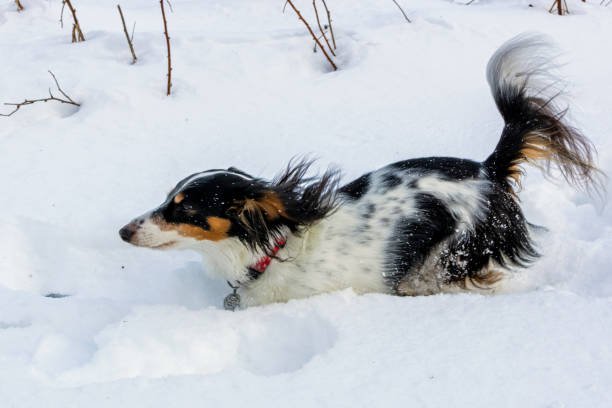
1. Stubbornness
Dachshunds can be stubborn, especially if they sense inconsistency in training. Be patient and use positive reinforcement to motivate them.
2. Independence
These dogs have an independent streak, which can make them less eager to please than some other breeds. Training may require more persistence.
3. Potential for Digging
Dachshunds have a strong prey drive and may dig in pursuit of burrowing animals. Provide them with designated digging areas to redirect this behavior.
4. Barking Tendency
Dachshunds are vocal and may bark at perceived threats or when they’re excited. Early training can help manage excessive barking.
5. Possessiveness
Some Dachshunds can be possessive of their toys or food. Training and early socialization can help prevent aggressive behavior related to possession.
Addressing Behavioral Issues
To address and manage challenging behavioral traits in long haired Dachshunds:
- Consistent Training: Consistency is key. Use positive reinforcement and reward good behavior to motivate your Dachshund.
- Early Socialization: Begin socialization and training as early as possible to prevent and address behavioral issues.
- Patience: Be patient with your Dachshund, as some traits, like stubbornness, may require time and persistence to overcome.
- Professional Help: If you’re struggling with behavioral issues, consider consulting a professional dog trainer or behaviorist for guidance.
In conclusion, long haired Dachshunds are delightful and unique companions, but they require proper training and socialization to become well-adjusted members of your family. Embrace their positive traits, address challenging behaviors with patience and consistency, and provide them with love and care to ensure they thrive as cherished pets.
Personal Stories and Testimonials from Long Haired Dachshund Owners
In this section, we’ll hear from real-life owners of long haired Dachshunds as they share their personal experiences, challenges, and joys of having this breed as a pet. Additionally, we’ll delve into the cost of owning a long haired Dachshund, including expenses related to grooming and care. Let’s explore the unique insights and stories that add a human touch to understanding this beloved breed.
Testimonial 1: The Joys of Owning a Long Haired Dachshund
Name: Sarah M.
I’ve been a long haired Dachshund enthusiast for over a decade, and my sweet boy, Max, has been with me for five wonderful years. Long haired Dachshunds are incredibly loyal and affectionate. Max follows me around the house like a little shadow, always ready for a cuddle or a game of fetch.
Challenges: One of the challenges we’ve faced is their stubbornness. Dachshunds have a mind of their own, and sometimes, Max likes to test boundaries. But with consistent training and patience, we’ve made great progress.

Expenses: Grooming expenses for Max’s long, luxurious coat can add up. Regular brushing and occasional trips to the groomer help keep his coat in top shape. But the love and joy he brings are worth every penny.
Testimonial 2: The Adventures of a Dachshund Duo
Name: Mike and Lisa C.
We’re the proud owners of two long haired Dachshunds, Bella and Charlie. These two have filled our lives with laughter and love. Long haired Dachshunds are incredibly playful, and they keep us entertained with their antics.
Joys: Watching Bella and Charlie play together is a daily delight. They have a strong bond and are the best of friends. Their affectionate nature warms our hearts, and they’ve become an integral part of our family.
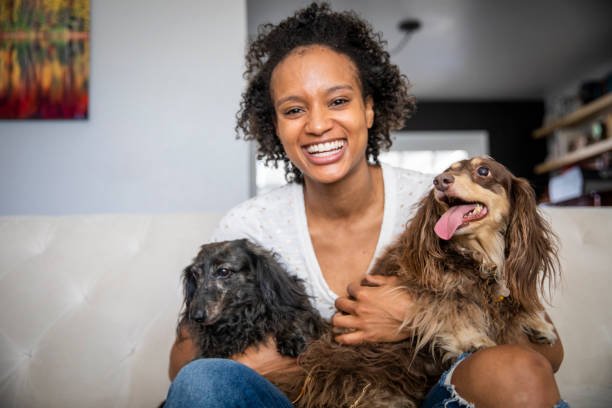
Challenges: Dachshunds are known for their barking, and Bella and Charlie are no exception. It took some training to manage their vocal tendencies, but it’s been worth the effort. We also had to invest in a sturdy fence to prevent any escape attempts—Dachshunds are notorious for digging!
Expenses: The cost of feeding and grooming two Dachshunds can add up, but their companionship is priceless. We’ve found that by buying pet supplies in bulk and keeping up with regular vet check-ups, we can manage our expenses effectively.
Testimonial 3: A Long Haired Dachshund’s Resilience
Name: Mark R.
Our long haired Dachshund, Daisy, has been a source of inspiration for our family. Despite being diagnosed with a minor health issue early in life, she’s shown remarkable resilience.
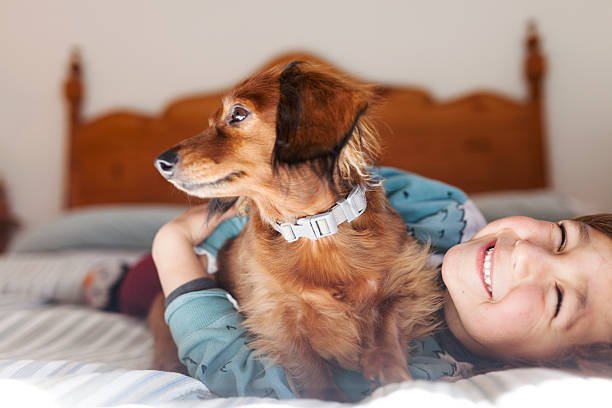
Challenges: Daisy has a sensitive stomach, which required dietary adjustments and regular vet visits. However, her strength and ability to adapt to her condition have been awe-inspiring. She’s taught us the value of determination and the importance of providing the best care possible for our beloved pets.
Joys: Daisy’s sweet and gentle nature makes her a cherished member of our family. She’s wonderful with our children and has formed a deep bond with them. Her long, flowing coat requires regular grooming, but it’s a small price to pay for her companionship.
The Cost of Owning a Long Haired Dachshund
Owning a long haired Dachshund comes with various expenses, including initial costs, grooming, healthcare, and everyday care. Here’s a breakdown of these expenses:
1. Initial Costs
- Purchase or Adoption: The cost of acquiring a long haired Dachshund can vary widely. Adoption fees typically range from $50 to $500, while purchasing from a breeder can range from $1,000 to $3,000 or more, depending on pedigree and breeder reputation.
- Supplies: Initial supplies such as food bowls, crate, leash, collar, toys, and bedding can cost approximately $100 to $200.
2. Grooming Expenses
Long haired Dachshunds require regular grooming to maintain their beautiful coats. Here are some grooming expenses to consider:
- Professional Grooming: Grooming appointments can range from $30 to $90, depending on your location and the complexity of the grooming.
- Brushes and Combs: Investing in high-quality brushes and combs for at-home grooming is essential and may cost around $20 to $50.
- Shampoo and Conditioner: Specific shampoos and conditioners for long haired breeds are recommended, costing approximately $10 to $20 per bottle.
3. Healthcare Costs
Routine veterinary care is crucial to ensure your Dachshund’s health. Here are potential healthcare expenses:
- Vaccinations: Annual vaccinations can cost between $50 and $100.
- Dental Care: Dental cleanings and treatments may range from $150 to $300 or more, depending on the severity of dental issues.
- Preventatives: Monthly flea, tick, and heartworm preventatives can add up to around $100 to $200 per year.
- Emergency Care: Unexpected medical expenses for emergencies or illnesses can vary significantly and may reach thousands of dollars.
4. Everyday Expenses
Owning any dog comes with ongoing everyday expenses:
- Food: High-quality dog food tailored to your Dachshund’s size and activity level can cost approximately $20 to $60 per month.
- Treats: Treats for training and occasional rewards may add another $5 to $20 per month.
- Toys and Accessories: Replacing toys, leashes, and collars periodically can amount to $50 to $100 per year.
- Pet Insurance: Consider pet insurance to help cover unexpected medical costs. Premiums typically range from $30 to $50 per month.
Pros and Cons of Having a Long Haired Dachshund as a Pet
Pros:
- Loyal Companionship: Long haired Dachshunds are known for their loyalty and affection. They form strong bonds with their owners and provide constant companionship.
- Playful Nature: They have a playful and mischievous side that adds joy and entertainment to your daily life.
- Low Exercise Needs: While they enjoy playtime, they don’t require excessive exercise, making them suitable for both apartments and homes with yards.
- Watchdog Abilities: Dachshunds are alert and make excellent watchdogs. They’ll let you know if anything seems amiss.
- Variety of Colors: Long haired Dachshunds come in various coat colors, allowing you to choose the one that captures your heart.
Cons:
- Stubbornness: Dachshunds can be stubborn, which can be challenging during training. Consistency and patience are key.
- Barking Tendencies: They are known to bark at perceived threats or when excited, which may require training to manage.
- Grooming Requirements: Their long, luxurious coat requires regular grooming to prevent matting and tangling.
- Health Concerns: Dachshunds are prone to certain health issues, including back problems like IVDD, which can be costly to treat.
- Possessiveness: Some Dachshunds can be possessive of their toys or food, requiring early socialization to prevent aggressive behavior.
In conclusion, owning a long haired Dachshund can be a rewarding experience, but it comes with expenses and challenges. The love and loyalty they offer make them cherished pets for many families. By understanding their unique characteristics and addressing their needs, you can enjoy a fulfilling life with your long haired Dachshund.
Breed-Specific Accessories and Care Products for Long Haired Dachshunds
Owning a long haired Dachshund comes with the joy of having a loyal and affectionate companion, but it also entails specific grooming and care needs. In this section, we’ll recommend breed-specific accessories and care products tailored to the long haired Dachshund breed’s needs. These items will help you keep your furry friend happy, healthy, and well-groomed.
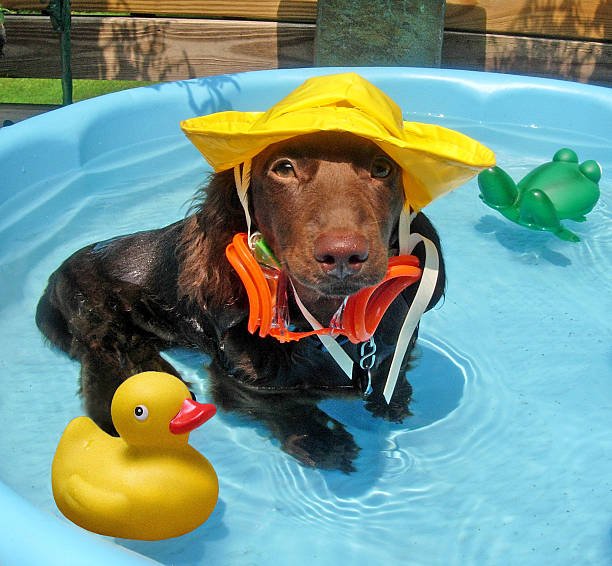
1. Grooming Tools
Maintaining the long and luxurious coat of a long haired Dachshund requires proper grooming tools. Here are some essential items:
Slicker Brush
A slicker brush is a must-have for long haired Dachshund owners. It helps detangle and remove loose hair from the coat while preventing mats and knots. Look for one with fine, wire bristles designed for long hair.
Undercoat Rake
Long haired Dachshunds have a dense undercoat that can become matted if not properly cared for. An undercoat rake helps thin out and remove loose undercoat hair, reducing shedding and preventing matting.
Stainless Steel Comb
A stainless steel comb with both wide and narrow teeth is ideal for maintaining your Dachshund’s coat. Use the wide teeth for general brushing and the narrow teeth for detailed work around ears and paws.
Nail Clippers
Regular nail maintenance is essential for your Dachshund’s comfort and health. Choose high-quality nail clippers that are comfortable to handle and provide a clean, precise cut.
Ear Cleaner
Dachshunds are prone to ear infections due to their floppy ears. Invest in a gentle ear cleaner specifically designed for dogs to keep their ears clean and healthy.
2. Harnesses and Collars
Finding the right harness or collar for your long haired Dachshund is crucial for their safety and comfort, especially during walks and outings. Here are some recommendations:
No-Pull Harness
Dachshunds can be prone to pulling on the leash, which can strain their backs. A no-pull harness distributes the pressure more evenly, reducing the risk of injury. Look for one with adjustable straps for a snug fit.
Adjustable Collar
Choose a comfortable and adjustable collar for everyday use. It should fit snugly without being too tight. Consider a collar with reflective elements for added safety during evening walks.
Front-Clip Harness
Front-clip harnesses are effective for dogs that tend to pull. They redirect your Dachshund’s attention toward you when they pull on the leash, making walks more manageable.
3. Toys and Enrichment Products
Keeping your long haired Dachshund mentally stimulated is essential for their well-being. Interactive toys and enrichment products can provide hours of entertainment. Here are some options:
Puzzle Toys
Puzzle toys challenge your Dachshund’s problem-solving skills and keep them engaged. Look for toys that dispense treats as a reward for solving the puzzle.
Interactive Feeding Bowls
Slow-feed bowls or puzzle feeders are excellent for preventing fast eating, which can lead to digestive issues. They make mealtime more interesting and mentally stimulating.
Plush Toys
Dachshunds often enjoy plush toys they can cuddle with. Opt for durable, plush toys designed for small breeds to withstand their enthusiastic play.
Chew Toys
Dachshunds have a natural instinct to chew. Provide them with safe, durable chew toys to satisfy this urge and prevent them from chewing on household items.
4. Dog Shampoo and Conditioner
Maintaining your long haired Dachshund’s coat cleanliness and health requires suitable dog shampoo and conditioner. Here’s what to look for:
Hypoallergenic Shampoo
Choose a hypoallergenic shampoo specifically formulated for dogs with sensitive skin. These shampoos are gentle on their skin and coat.
Conditioner for Long Coats
A conditioner designed for long coats helps keep your Dachshund’s fur soft, silky, and manageable. It prevents tangles and matting, making grooming easier.
5. Dog Bed
Long haired Dachshunds love to curl up and snuggle. Providing them with a comfortable dog bed gives them a cozy spot to relax. Look for beds with orthopedic support, especially if your Dachshund is older or has joint issues.
6. Dog Ramp or Stairs
Due to their elongated bodies, Dachshunds are prone to back problems, including intervertebral disc disease (IVDD). To prevent unnecessary strain on their backs, consider investing in a dog ramp or stairs to help them access furniture or vehicles safely.
7. Pet Insurance
Pet insurance is a valuable investment for your long haired Dachshund’s health. It can help offset the costs of unexpected medical expenses, especially for breed-specific issues like IVDD.
8. Doggie Dental Kit
Dental care is essential for your Dachshund’s overall health. A doggie dental kit typically includes a toothbrush and toothpaste formulated for dogs. Regular dental care helps prevent dental problems and keeps their breath fresh.
9. Dog ID Tags
Ensure your Dachshund’s safety by outfitting them with a durable dog ID tag. Include essential information like their name, your contact number, and any medical conditions or allergies.
10. Poop Bags and Dispenser
Responsible dog ownership means cleaning up after your pet during walks. Invest in eco-friendly poop bags and a dispenser that attaches to your leash for convenience.
Remember that each Dachshund is unique, so it’s essential to choose accessories and care products that suit their individual needs and preferences. Regular grooming, exercise, and mental stimulation, combined with the right accessories, will help keep your long haired Dachshund happy and healthy throughout their life.
Frequently Asked Questions (FAQs) About Long Haired Dachshunds
In this section, we’ll address some of the most common questions that prospective and current long haired Dachshund owners often have. These FAQs cover a range of topics related to this unique breed, from their characteristics to care and training.
1. Are Long Haired Dachshunds the Same as Smooth Haired Dachshunds?
No, long haired Dachshunds and smooth haired Dachshunds are not the same. They are variations of the Dachshund breed with different coat types. Long haired Dachshunds have, as the name suggests, long and silky coats, while smooth haired Dachshunds have short, smooth coats. There is also a wirehaired variety with a rough and dense coat.
2. How Do I Properly Groom a Long Haired Dachshund?
Grooming a long haired Dachshund involves regular brushing to prevent matting and tangling. Start by brushing their coat with a slicker brush or undercoat rake to remove loose hair and tangles. Pay special attention to their ears, as they are prone to ear infections. You may also need to trim their nails and clean their teeth regularly.
3. Are Long Haired Dachshunds Prone to Health Issues?
Like all dog breeds, Dachshunds can be prone to certain health issues. Long backed Dachshunds, in particular, are more susceptible to intervertebral disc disease (IVDD), a spinal condition. It’s essential to be aware of this risk and take preventive measures, such as providing proper support for their backs and avoiding activities that put strain on their spines.
4. Are Long Haired Dachshunds Good with Children?
Long haired Dachshunds can be good family dogs and are often good with children when properly socialized. However, due to their small size and potential for back problems, it’s crucial to supervise interactions between Dachshunds and young children to prevent accidental injuries.
5. Do Long Haired Dachshunds Get Along with Other Pets?
Long haired Dachshunds can get along with other pets if properly socialized from a young age. They have a hunting instinct, so early exposure to other animals is essential. Keep in mind that individual personalities vary, and some Dachshunds may have a higher prey drive than others.
6. What Is the Average Lifespan of a Long Haired Dachshund?
The average lifespan of a long haired Dachshund is around 12 to 15 years, but with proper care, they can live even longer. Providing them with a balanced diet, regular exercise, and routine veterinary check-ups can help promote a longer and healthier life.
7. Do Long Haired Dachshunds Require Special Exercise?
While Dachshunds are active dogs, they don’t have extremely high exercise needs. Daily walks and playtime are usually sufficient to keep them happy and healthy. Be cautious about activities that involve jumping, as it can strain their backs. Swimming is an excellent low-impact exercise option for Dachshunds.
8. Are Long Haired Dachshunds Easy to Train?
Long haired Dachshunds are intelligent but can be a bit stubborn. Training them requires patience, consistency, and positive reinforcement techniques. Early socialization and basic obedience training are essential for a well-behaved Dachshund.
9. Can Long Haired Dachshunds Live in Apartments?
Yes, long haired Dachshunds can adapt well to apartment living if they receive sufficient exercise and mental stimulation. They are small in size, making them suitable for smaller living spaces. Regular walks and playtime indoors can help meet their activity needs.
10. How Do I Find a Reputable Breeder or Rescue for Long Haired Dachshunds?
To find a reputable breeder, look for breed clubs or organizations dedicated to Dachshunds. Research potential breeders thoroughly, ask for references, and visit their facilities if possible. For rescue Dachshunds, consider contacting Dachshund-specific rescue organizations or checking local animal shelters and online adoption platforms. Always prioritize adopting from reputable sources to support responsible breeding practices and rescue efforts.
These FAQs cover many aspects of long haired Dachshunds, helping you better understand this unique breed and what it takes to provide them with a happy and healthy life. If you have more questions or need further information, don’t hesitate to consult with experienced Dachshund owners or reach out to breed-specific organizations for guidance and support.
Conclusion: Long Haired Dachshunds – Loving Companions with Unique Needs
In this comprehensive guide, we’ve delved into the world of long haired Dachshunds, a delightful breed known for its loyalty, affection, and distinctive long and silky coats. Let’s take a moment to summarize the key points we’ve covered throughout this article and emphasize the importance of responsible ownership, including proper care, training, and socialization. Additionally, we’ll encourage you to explore adoption options and provide resources for further information.
Recap of Key Points
- Breed Characteristics: Long haired Dachshunds are a variation of the Dachshund breed, known for their elongated bodies and long, flowing coats. They come in various coat colors and patterns.
- History and Origin: We explored the historical development of the long haired Dachshund breed, tracing their roots to Germany and discussing the influence of different breeds in their formation.
- Physical Traits: Long haired Dachshunds are small to medium-sized dogs with distinctive features like their elongated bodies, short legs, and expressive eyes. Their long coats require regular grooming.
- Temperament: These dogs are known for their loyalty, playfulness, and alertness. While they can be stubborn, proper training and socialization help them become well-rounded pets.
- Health Considerations: Long haired Dachshunds are prone to certain health issues, particularly spinal problems like intervertebral disc disease (IVDD). Responsible ownership includes regular veterinary check-ups and preventive measures.
- Exercise and Care: They have moderate exercise needs and adapt well to apartment living with daily walks and playtime. Special attention to their backs is crucial to prevent injury.
- Adoption and Responsible Breeding: We highlighted the importance of adopting from reputable rescues and breed-specific organizations. When considering a breeder, it’s essential to prioritize responsible breeding practices, including health screenings and genetic diversity.
- Breed-Specific Accessories: We recommended grooming tools, harnesses, toys, and other accessories tailored to long haired Dachshunds’ needs.
- Frequently Asked Questions: We addressed common questions about this breed, covering topics from grooming to training, health, and suitability for families.
Responsible Ownership: A Lifelong Commitment
Owning a long haired Dachshund is a rewarding but lifelong commitment. These dogs bring joy, companionship, and love to their families, but they also rely on responsible owners to meet their unique needs. Here are some essential principles of responsible ownership:
1. Proper Care and Health Maintenance
Responsible owners ensure their Dachshunds receive the care they need. This includes:
- Regular veterinary check-ups to monitor their health and address any concerns promptly.
- A balanced diet tailored to their size, age, and activity level.
- Grooming and coat care to prevent matting and maintain their beautiful coats.
- Dental care, including brushing and regular dental check-ups.
- Adequate exercise and mental stimulation to keep them happy and healthy.
2. Training and Socialization
Dachshunds benefit from early socialization and training to become well-behaved companions. Training should be positive, consistent, and patient, taking into account their stubborn tendencies. Socialization helps them adapt to various people, animals, and environments.
3. Safety and Preventive Measures
Responsible owners take steps to protect their Dachshunds from potential dangers. This includes:
- Using appropriate harnesses and leashes during walks to avoid strain on their backs.
- Creating a safe and secure environment to prevent accidents.
- Providing proper support and precautions to minimize the risk of spinal issues like IVDD.
4. Love and Companionship
Long haired Dachshunds thrive on human companionship and affection. Responsible owners ensure their dogs are part of the family, enjoying love, attention, and social interaction.
5. Adoption Advocacy
While responsible breeders play a role in maintaining the breed’s health and standards, adoption is an excellent way to provide a loving home to Dachshunds in need. There are many long haired Dachshunds waiting for forever homes in shelters and rescue organizations.
Encouraging Adoption and Resources for Further Information
We strongly encourage prospective Dachshund owners to explore adoption options. Here are some resources and organizations that can help you find your perfect long haired Dachshund companion:
- Local Animal Shelters: Visit your local animal shelters and rescue organizations to inquire about available Dachshunds for adoption.
- Dachshund-Specific Rescue Groups: Many rescue organizations specialize in Dachshund breeds and have dedicated resources for finding the right match.
- Online Adoption Platforms: Websites and apps like Petfinder and Adopt-a-Pet offer searchable databases of Dachshunds available for adoption.
- Dachshund Breed Clubs: Connect with Dachshund breed clubs and enthusiasts who can provide valuable information about adoption opportunities and breed-specific advice.
In conclusion, long haired Dachshunds are charming, loving, and unique companions that bring immense joy to their owners. Responsible ownership involves meeting their specific needs, ensuring their health and happiness, and considering adoption as a compassionate way to provide a loving home to these wonderful dogs. By following the guidelines and principles outlined in this comprehensive guide, you can embark on a fulfilling journey with your long haired Dachshund, creating cherished memories that last a lifetime.
















